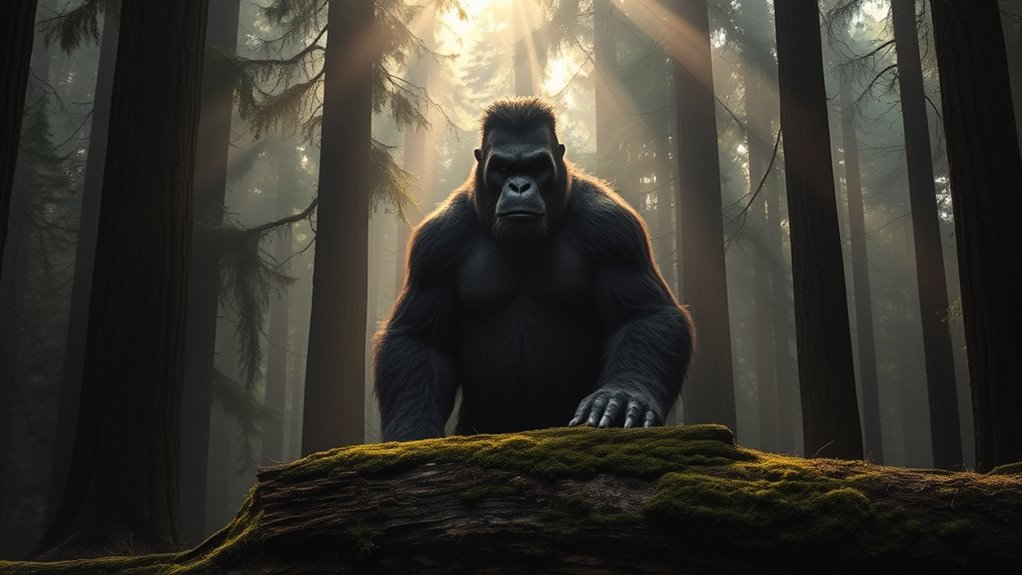Bigfoot, also known as North America’s hairy giant, has fascinated many with numerous reports of towering, hairy beings in remote forests. Researchers use footprint analysis, audio recordings, camera traps, and advanced technology like thermal imaging to seek evidence. Despite skepticism and inconclusive proof, the legend endures through countless sightings and ongoing efforts. If you want to discover more about this mysterious creature and the latest investigations, there’s much more to uncover about Bigfoot’s enduring mystery.
Key Takeaways
- Bigfoot is a legendary, large, hairy creature reported across North American forests, often seen as a mysterious ape-like being.
- Sightings include footprints, sounds, and visual encounters, fueling ongoing interest and research.
- Researchers use technology like camera traps, thermal imaging, and audio recordings to gather evidence.
- Skepticism exists due to inconclusive proof and potential misidentifications, but the legend persists.
- The Bigfoot myth continues to inspire investigations, cultural stories, and public fascination worldwide.

Ever wonder what makes Bigfoot one of the most intriguing mysteries in North America? It’s the countless Bigfoot sightings reported by hikers, campers, and locals that fuel the curiosity and debate surrounding this elusive creature. Over the years, people have claimed to see towering, hairy beings wandering through forests, often leaving behind strange footprints or mysterious sounds. These reports, while varied, create a tapestry of evidence that keeps the legend alive. But what exactly are researchers doing to verify these sightings? That’s where Bigfoot research methods come into play.
You might be surprised to learn that investigators employ a mix of traditional fieldwork and modern technology to hunt for clues. Footprint analysis is a common starting point; researchers carefully examine castings of footprints to determine their size, stride, and depth. They look for unique features, like dermal ridges or claw marks, which could help distinguish a genuine Bigfoot track from a hoax or animal print. Audio recordings also play a vital role. Researchers set up audio equipment to capture potential vocalizations or unusual sounds—such as howls, whoops, or knocking noises—that are often reported during Bigfoot sightings. These sounds, if authentic, could provide valuable insight into the creature’s behavior and presence.
Another key method involves camera traps—motion-activated cameras placed in areas with frequent sightings. When triggered, these cameras can capture images or videos of any passing creature, providing visual evidence that can be analyzed later. Many researchers also use night-vision and thermal imaging devices to detect movement in low-light conditions, increasing their chances of spotting Bigfoot in its natural habitat. Additionally, some researchers are exploring emerging technologies like drone surveillance and AI analysis to enhance their search efforts. These methods, combined with meticulous data collection, help build a more thorough picture of whether Bigfoot exists or if sightings are just misidentifications or fabrications.
Despite the scientific rigor, skepticism remains. Still, the passion and persistence of those dedicated to Bigfoot research methods keep the legend alive. Every footprint cast, audio recording, or camera snap contributes to the ongoing investigation, even if definitive proof remains elusive. For enthusiasts, it’s about exploring the unknown and keeping the hope alive that someday, perhaps, Bigfoot will step into the light of scientific validation. Until then, the mystery endures, fueled by countless sightings and the relentless quest to uncover the truth behind North America’s legendary hairy giant.
Frequently Asked Questions
Has Bigfoot Been Officially Recognized by Any Government Agency?
Bigfoot hasn’t received government recognition or official status from any agency. While many sightings and evidence exist, no scientific proof or official acknowledgment has been made. You might find various reports and claims, but these lack the validation needed for official recognition. Until definitive scientific evidence emerges, Bigfoot remains a legendary creature rather than an officially recognized one by any government agency.
What Are the Most Recent Scientific Discoveries Related to Bigfoot?
You might think the trail’s gone cold, but recent discoveries keep the Bigfoot mystery alive. The latest DNA analyses suggest some samples could belong to an unknown primate, sparking new debates. Additionally, new footprint evidence continues to surface, hinting at a creature that’s yet to be officially identified. These findings keep enthusiasts and scientists on their toes, proving that sometimes, the best is yet to come in uncovering this elusive giant’s story.
Are There Any Known Bigfoot Populations Outside North America?
There are no confirmed Bigfoot populations outside North America. Some believe these creatures might have extraterrestrial origins or are mythical creature status, but no scientific evidence supports their existence elsewhere. You might hear stories from other regions, but these remain unverified. If you’re curious, stay skeptical and follow credible research, as current data doesn’t confirm Bigfoot’s presence outside North America or link it to extraterrestrial origins.
What Are the Common Features That Distinguish Bigfoot From Other Creatures?
You’ll notice Bigfoot’s distinct features, like its large, muscular physique, tall stature of 7-10 feet, and thick, dark hair covering its body. Its habitat preferences include remote forests, mountains, and wilderness areas, where it remains elusive. Unlike bears or primates, Bigfoot’s footprints are large and human-like, with dermal ridges. These physical traits and habitat choices set Bigfoot apart from other creatures.
How Do Local Cultures Interpret Bigfoot Legends?
You’ll find that local cultures interpret Bigfoot legends through cultural symbolism and folklore variations. Many see Bigfoot as a guardian spirit, a symbol of wilderness, or a spiritual guide. In some traditions, it’s a protector of nature, while others see it as a trickster. These interpretations reflect each community’s unique beliefs and history, shaping how they tell stories, preserve traditions, and understand the mysterious presence of Bigfoot in their landscapes.
Conclusion
So, even if you remain skeptical about Bigfoot, the countless sightings and stories can’t be ignored. The mystery fuels curiosity and keeps the legend alive, inspiring explorers and believers alike. Remember, not every mystery needs full proof to be enthralling—sometimes, the thrill of the unknown is enough. Whether or not you think Bigfoot exists, the legend reminds us to stay curious and open-minded about the world’s unexplained wonders.










